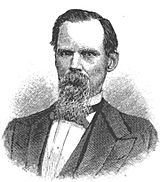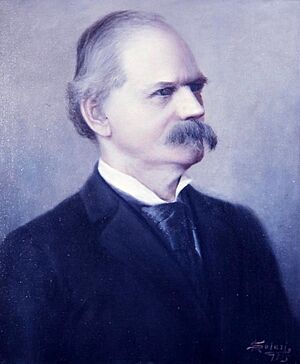John Marshall Stone facts for kids
Quick facts for kids
John Marshall Stone
|
|
|---|---|
 |
|
| 31st and 33rd Governor of Mississippi | |
| In office March 29, 1876 – January 2, 1882 |
|
| Lieutenant | Vacant (1876–1878) William H. Sims (1878–1882) |
| Preceded by | Adelbert Ames |
| Succeeded by | Robert Lowry |
| In office January 13, 1890 – January 20, 1896 |
|
| Lieutenant | M.M. Evans |
| Preceded by | Robert Lowry |
| Succeeded by | Anselm J. McLaurin |
| Member of the Mississippi State Senate | |
| In office 1869–1876 |
|
| Personal details | |
| Born | April 30, 1830 Milan, Tennessee |
| Died | March 26, 1900 (aged 69) Holly Springs, Mississippi |
| Political party | Democratic |
| Signature | |
John Marshall Stone (born April 30, 1830 – died March 26, 1900) was an American politician. He was from the state of Mississippi. Stone was a member of the Democratic Party. He served as the Governor of Mississippi for a long time. He was governor from 1876 to 1882. Then he served again from 1890 to 1896. During his time, a new constitution was approved in 1890. This constitution made it very hard for most African Americans to vote. This meant they were kept out of the political system for about 70 years.
Contents
Early Life and Education
John Stone was born in Milan, Tennessee. His parents, Asher and Judith Stone, had moved from Virginia. His family was not wealthy. Because of this, John did not go to college. However, he studied a lot on his own. He eventually became a school teacher. He lived in Jacks Creek, Tennessee for a while. In 1855, he moved to Tishomingo County, Mississippi. Later, he became a station agent in Iuka. This was when the Memphis and Charleston Railroad opened.
Military Service in the Civil War
When the American Civil War began in 1861, Stone joined the Confederate army. He joined in April of that year. He led Company K of the Second Mississippi Infantry. He fought in battles in Virginia. Stone became a colonel in 1862. He was put in charge of a different group of soldiers. His commanders praised him highly for his leadership. In 1864, he often led a larger group called a brigade. In January 1865, he went back to Mississippi to find new soldiers. He then led local defense troops. They were fighting against Stoneman's Raid. Stone and his men were captured in North Carolina. They were held as prisoners in Ohio.
Political Career in Mississippi
After the war ended, Stone went back to Tishomingo County. He was elected as the mayor and treasurer there. In 1869, he won a race to become a state senator. He was re-elected in 1873. During this time, state elections had many problems. Groups tried to stop African Americans from voting. They also tried to remove Republican officials from office.
In 1876, Governor Adelbert Ames resigned. Stone was the leader of the Mississippi Senate at the time. So, he became the acting governor. In the 1877 election, Stone won the Governor's office. He ran as a Democrat. In 1881, he lost his re-election bid to Robert Lowry.
Stone became Governor again after winning the 1889 election. A new state constitution was approved in 1890. This constitution extended the governor's term until 1896. The state legislature was controlled by Democrats. They wanted to keep control of the state. They also wanted to maintain white supremacy. So, they made it very hard for most African Americans to vote. They added a rule that voters had to pay a poll tax. Two years later, new laws were passed. These laws required literacy tests. White officials gave these tests unfairly. There were also "grandfather clauses" that helped white citizens.
These new rules greatly reduced the number of African Americans who could vote. In Mississippi, the number of black voters dropped by 90%. Only a few prominent black leaders were allowed to vote in each county. African Americans were mostly kept out of the political system for 70 years. This changed after new federal civil rights laws were passed in the 1960s. Other southern states soon adopted similar rules. This led to a big drop in voters across the South. White Democrats then controlled politics in these states.
Later Life and Legacy
After his time as governor, Stone took a new job in 1899. He became the second President of Mississippi A&M. This school is now known as Mississippi State University. It is located in Starkville.
Stone died in Holly Springs, Mississippi, in 1900. He was 69 years old. He is buried at Oak Grove Cemetery in Iuka, Mississippi.
Personal Life
After the Civil War, Stone married Mary G. Coman in 1872. They had two children who sadly died young. They later adopted three children from John's brother. They raised these children as their own.
Honors and Memorials
- In 1916, Stone County, Mississippi, was named after him. This happened after his death.
- Stone Boulevard at Mississippi State University is also named for him.
- The John M. Stone Cotton Mill in Starkville was once named in his honor. However, it was renamed after the university bought it in 1962. This building was used by the university police. It has since been taken down.


